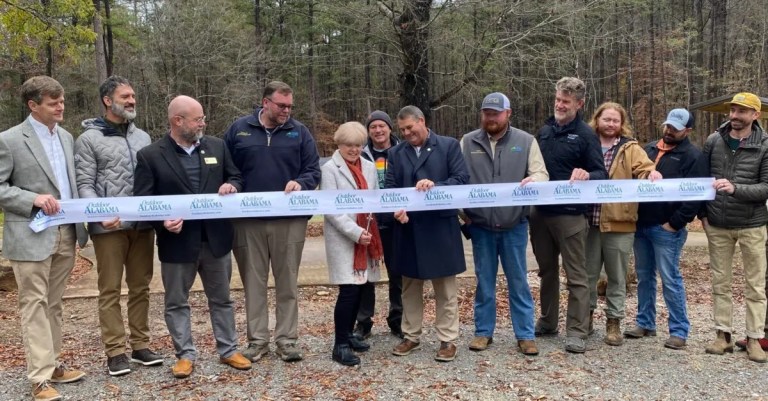4 easy steps to using iNaturalist to become a citizen scientist, featuring Birmingham’s Kiwanis Vulcan Trail
Reading time: 6 minutes

For the past year, I’ve donned my citizen scientist hat and used iNaturalist to identify all sorts of bugs, plants and birds in Birmingham. If you love nature and science, if you have kids and want an educational way to integrate tech and the real world—or if you just want to know what the H is that bug clinging to your window—iNaturalist if for you. It’s free and easy, and I’m going to walk you through your first ID.

I found this guy hanging out on a leaf while walking on Kiwanis Vulcan Trail in Birmingham yesterday. You can access this trail from the Kiwanis Centennial Park Plaza, on the north side of Vulcan Park and Museum.

The trail is fairly urban. The WBRC sign overlooks the kudzu-covered hillside above you.

As you walk along the trail, breaks in the trees reveal vista after vista of downtown Birmingham.

Keep your eyes peeled because you’ll see lots of interesting flora and fauna along the trail. That’s where your iNaturalist app comes in. Let’s get started.

1. Understand The Basics
At its core iNaturalist is crowdsourcing. Participants range from amateur nature enthusiasts to professional scientists, and everyone works together to document biodiversity locally and worldwide.

iNaturalist works on a two-thirds majority. When 2 of 3 users agree on an ID, an observation is tagged as research grade. That means your observation can be used as a data point in all sorts of scientific studies, making you a certified boots-on-the-ground citizen scientist. Cool beans, right?

Do the best you can (it’s okay, you’ll get better), and rest assured the iNaturalist community will eventually correct any errors you make before your data ends up in a research study.

iNaturalist identification software helps novice citizen scientists make IDs, and you learn so much in the process. Teach your own young grasshoppers how to use it, and they’ll be the rockstars of science class.

2. Set Up Your iNaturalist Online Profile And Download The App
After you set up your profile, check out iNaturalist’s features, such as “Explore.” It allows you to check out others’ observations on interactive maps. Look at all the observations logged by your fellow citizen scientists in Birmingham and Jefferson County in the map below.

3. Log Your First Observation
Remember Mr. Insect from the top of this post? Let’s identify this Birmingham bug.

- Open the iNaturalist app. Then choose the camera icon that says “Observe.”
- Next, take a photo through the app, or upload one from your library. You can upload multiple photos for one observation—for instance, one of a flower and the other of leaves of the same plant. The extra visual information aids the software and other iNaturalist users with identifications.
- Next, you’ll see the screen below. We’re going to fill it out, then share our data.

Tips And Tricks: The Observation Form
- Location: the location function works similarly to Google Maps. Zero in on your location and save it.
- Geo Privacy: leave it open if you’re in a public space. If you’re at home, obscure it for privacy. As a safety measure, you may also want to obscure your geo location if you visit the same trail at the same time of day on the reg.
- Captivated / Cultivated: ask yourself, did man put this here? It matters because only noncaptive/noncultivated observations can be used for scientific research by others. You can still log captivated or cultivated species for your personal research.
- Projects: Don’t worry too much about projects in the beginning. Biodiversity of Alabama is a good one to tag in your observations. Others may add your observations to relevant projects, or you might look for relevant groups yourself, such as eButterfly North America or Fauna of Ruffner Mountain, as the case may be.
- What did you see? This is where the identification software comes in. Click “What did you see?” Next, you’ll see the screen below.

Voila! iNaturalist suggested a genus and possible species. Now it’s time to use your noggin.
- Compare and contrast the software’s suggested identifications against your own photos. Do all the details match?
- Think about the context: Where are you? What’s the time of year? Does everything jibe with the information in the suggested ID?
- Now make your ID and share it!
For this example, I chose the end-band net-winged beetle. Sometimes it takes a while, but in this case, another iNaturalist user confirmed the ID within the hour.
Our Mr. Bug is a research-grade observation of an end-band net-winged beetle in Birmingham. Boom!

Tips And Tricks: When You Can’t ID A Species
Sometimes it’s easy to identify a species. Other times, it’s harder. The software can still help you drill down to the genus, family or further up the taxonomic line.

Notice how in the photo above I was only able to ID the family? You can even be as vague as “flowering plant.” Just know that the more specific you are, the more likely it is a researcher or fellow citizen scientist will look at your observation.

4. Give Back By Identifying Others’ Observations
Crowdsourcing works by everyone joining in. Once you get the hang of iNaturalist, check out others’ observations that need an ID, and see if you can help.

I only chime in on others’ observations when I’m sure. But I promise, once you use iNaturalist for a while, your identification powers will surprise.
Got it? Good. Now get to it, Birmingham, you citizen scientists you!



